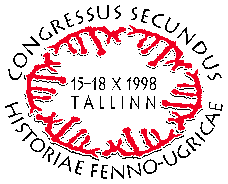 Plenary
session
Plenary
session Plenary
session
Plenary
session
Xenophont Sanukov
Yoshkar-Ola
FINNO-UGRIC
PEOPLES OF RUSSIA BEFORE 1917:
PROBLEMS OF HISTORIOGRAPHY
Summary
In pre-revolutionary Russian historiography, the history of Finno-Ugric, as well as other non-Russian peoples (inorodets), neither was nor could be a subject of scientific study. At the same time, N.M.Karamzin, S.M.Solov’yev and others authors included into the general historical context the events connected with these peoples’ conquest, viewing them from the angle of formation of the Russian state. At the close of the 19th century, historical and ethnographic essays on some Finno-Ugric peoples were published (I. N. Smirnov, N. N. Kharuzin). Inherent to these works is their Russo-centrism. The Finno-Ugrians are depicted not as independent subjects of history but as mere objects of Russian policy, of the Russian cultural influence, of russification. These peoples were denied a history of their own.
The Soviet historical science of the 1920s (the “Pokrovsky’s school”) abandoned Russo-centrism in many respects. By and large, the Moscow’s violent conquest of non-Russian peoples and its policy of ethnic colonial oppression were evaluated without bias. That was M. N. Pokrovsky who wrote: “The Great Russia was built on the bones of non-Russians” (1). This period permitted intellectuals of native origin to make a substantial contribution to the studies of their peoples’ history, culture and ethnography (the Udmurts had Kuzebay Gerd, the Maris had Fyodor Yegorov, etc.).
In 1930s, these intellectuals were accused as henchmen of “bourgeois nationalism” and “Pan-Finnism” and repressed just for having studied their peoples’ history from the viewpoint of those peoples themselves, for having stressed the heroic past and the resistance to conquest and russification (2). The new generation to take their place was indoctrinated with the “materialistic perception of history”; its mind was colonized. Whereas the Party inculcated the “class approach” in treating the past, the Russian great-power attitude was reanimated in historical science. This was particularly evident in the treatment of the central topic of those peoples’ history: the annexation of Finno-Ugric peoples by Russia was now considered as “the least evil” – and, later, as the absolute good. The doctrine of “peaceful colonization” by the Russians of free, “empty” lands in Finno-Ugric areas in the north and east Russia was widely propagandized.
Examples of “class struggle” were overemphasized, social differentiation in Finno-Ugric communities was exaggerated. On the other hand, factors of cultural and historical development were ignored. The genuine history of the peoples’ national ascent in the beginning of the 20th century, as well as the activity of their arising democratic intelligentsia, were boldly falsified. The first to be condemned was the movement of Shamil, followed by branding the national liberation wars of the second half of 16th century as “reactionary mutinies” of Mari, Udmurt and other feudal lords.
A new period of half-truth interpretation of the Finno-Ugric peoples’ past that began with the Khrushchev’s thaw was reflected in a series of essays on history of “independent republics” published at that time. This period was marked with considerable progress in the studies of ethnogenesis and history of many peoples (3).
In 1980s, the scope of Finno-Ugric studies was quantitatively growing. Histories of autonomous republics were published, their first volumes treating the pre-revolutionary period. In elucidating the indigenous peoples’ history, however, they contained nothing new.
The late 1980s and the early 1990s were marked with national awakening of the Finno-Ugrians of Russia. As in the beginning of the century, this process was accompanied by the rise of attention to their history. Cleared from the Marxist-Leninist dogmas, the class approach and Russo-centric falsifications, the history of peoples was read anew and revised. In the changed atmosphere, the functions of Finno-Ugric studies expanded and historical matters started being broadly treated at conferences and congresses (e.g. at the 1st All-Russia Conference of Finnougrists held in Yoshkar-Ola in November 1994 and the 8th International Congress in Yyväskylä in August 1995).
The 1st International Congress “Historica Fenno-Ugria” (Oulu, 1993) was an important event in the cultural and scientific life of the kindred peoples.
Many a problem of ethnic, cultural, social and political history from the antiquity up to our time were treated at conferences and “round tables” held in Yoshkar-Ola, Sombathei, Tartu, Syktyvkar, Kausala and elsewhere.
Apart from activization of scientific research, amateur publications on history started appearing that treat some plots of mythologized history at a new level (like the Golden Age of ancestors, the Great Biarmia, the identity of Mari and Merya peoples, etc.). At the same time, in historical literature myths are reanimated of the Volga and Siberian peoples having “voluntarily” joined Russia, of the Russians having “peacefully settled” in “empty” lands – the lands where archaeologists find an abundance of ancient Finno-Ugric monuments. Like a century ago, attempts are made to demonstrate the slavic, instead of Finno-Ugric, origin even of such geographical names as Volga and Moskva.
In such conditions, a wider and deeper scientific research in the history of Finno-Ugric peoples appears to be rather topical.
1. M. N. Pokrovsky. Vozniknoveniye Moskovskogo gosudarstva i ‘velikorusskaya narodnost’ (The Rise of the Moscow State and the ‘Great Russian Nation’) // Istorik-marksist. 1930, Vol. 18/19, p. 28.
2. K. N. Sanukov. ‘Finno-ugorskiye federalisty’ i ‘finskiye shpiony’ (‘The Finno-Ugric Federalists” and ‘the Finnish Spies’ // Finno-ugrovedeniye. 1996, Vol. 3; K. I. Kulikov. Delo SOFIN (The Case of SOFIN). Izhevsk, 1997.
3. Voprosy etnichyeskoy istorii estonskogo naroda (Questions of Ethnic History of the Estonians). Tallinn, 1956; Etnogenez mordovskogo naroda (Ethnogenesis of the Mordovian Nation). Saransk, 1965; Proiskhozhdeniye mariyskogo naroda (The Origin of the Mari Nation). Yoshkar-Ola, 1967; V. V. Pimenov. Vepsy. Ochyerk etnichyeskoy istorii i genezisa kul'tury. (The Vepsians: An Essay On Ethnic History and Genesis of Culture). Moscow-Leningrad., 1965; L. P. Lashuk. Formirovaniye narodnosti komi (The Rise of the Komi People). Moscow, 1971; N. F. Mokshin. Etnichyeskaya istoriya mordvy (An Ethnic History of the Mordovians). Saransk, 1977; K. I. Kozlova. Ochyerki etnichyeskoy istorii mariyskogo naroda (Essays on Ethnic History of the Mari Nation). Moscow, 1978.
Translated by Valeri Kalabugin